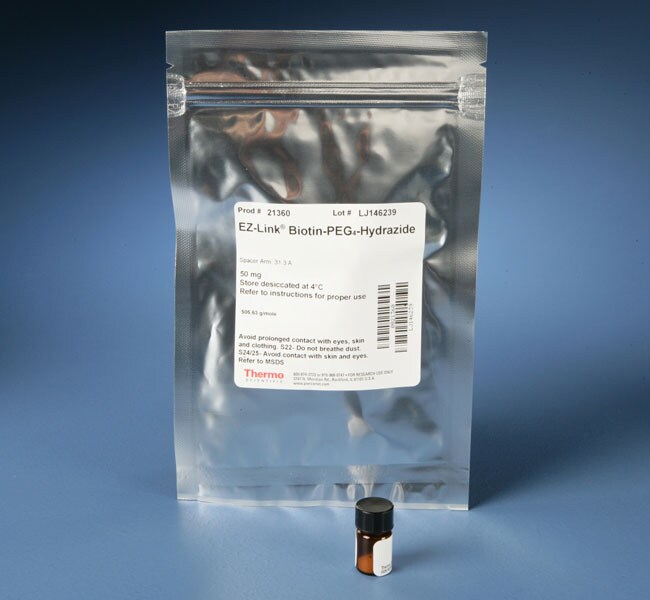
Thermo Scientific EZ-Link Hydrazide-PEG4-Biotin (also called Biotin-PEG4-Hydrazide) is an aldehyde-reactive biotinylation reagent that contains a 4-unit polyethylene glycol (PEG) spacer arm for increased hydrophilicity.
Features of EZ-Link Hydrazide-PEG4-Biotin:
• Glycoprotein labeling—biotinylate glycosylated proteins at sialic acid residues for detection or purification using streptavidin probes or resins
• Cell surface labeling—biotinylate and isolate cell surface glycoproteins; reagent does not permeate membranes of whole cells
• Aldehyde-reactive—reacts with aldehydes formed by periodate-oxidation of sugar groups
• Hydrazide-activated—perform reactions at pH 4 to 6 in buffers such as sodium acetate
• Pegylated – spacer arm contains a hydrophilic, 4-unit, polyethylene glycol (PEG) group
• Enhances solubility – pegylation imparts water solubility to the biotinylated molecule, helping to prevent aggregation of biotinylated antibodies stored in solution
• Irreversible—forms semi-permanent hydrazone bonds; spacer arm cannot be cleaved
• Solubility—usually dissolved in DMSO to make concentrated stock solution
• Long reach—spacer arm (total length added to target) is 31.3 angstroms
Biotin-PEG4-Hydrazide enables biotinylation of glycoproteins and other molecules containing aldehydes or oxidizable sugar groups. The hydrazide group reacts spontaneously with aldehyde or ketone groups to form a stable hydrazone bond. Aldehyde groups can be created by gentle periodate oxidation of cis-diols in sialic acid and other sugars in carbohydrates. The hydrophilic, 4-unit polyethylene glycol (PEG) spacer arm imparts water solubility that is transferred to the biotinylated molecule, thus reducing aggregation of labeled proteins stored in solution. The PEG segment also adds length and flexibility to the spacer arm, minimizing steric hindrance involved with binding to avidin molecules.
We manufacture biotin reagents to ensure the highest possible overall product integrity, consistency and performance for the intended research applications.
Biotinylation reagents differ in reactivity, length, solubility, cell permeability and cleavability. Hydrazides and alkoxyamines are two types of carbonyl-reactive groups. Hydrazides (—NH-NH2) react specifically with aldehyde groups in slightly acidic conditions to form hydrazone linkages; these can be further reduced to stable secondary amine bonds using sodium cyanoborohydride (Part No. 44892). The reaction is more efficient in the presence of aniline (Part No. 88944). Alternatively, hydrazides can be conjugated to carboxylic acids using EDC carbodiimide chemistry.
Reactive aldehyde groups can be generated in glycoproteins and other polysaccharide compounds by oxidation of constituent sugar diols using sodium periodiate (Part No. 20504). Sialic acid residues are common components of protein glycosylation and are easily converted to aldehydes with 1 mM NaIO4.
| Code | Description |
|---|---|
| 21360 | Catalog Number: 21360 |

